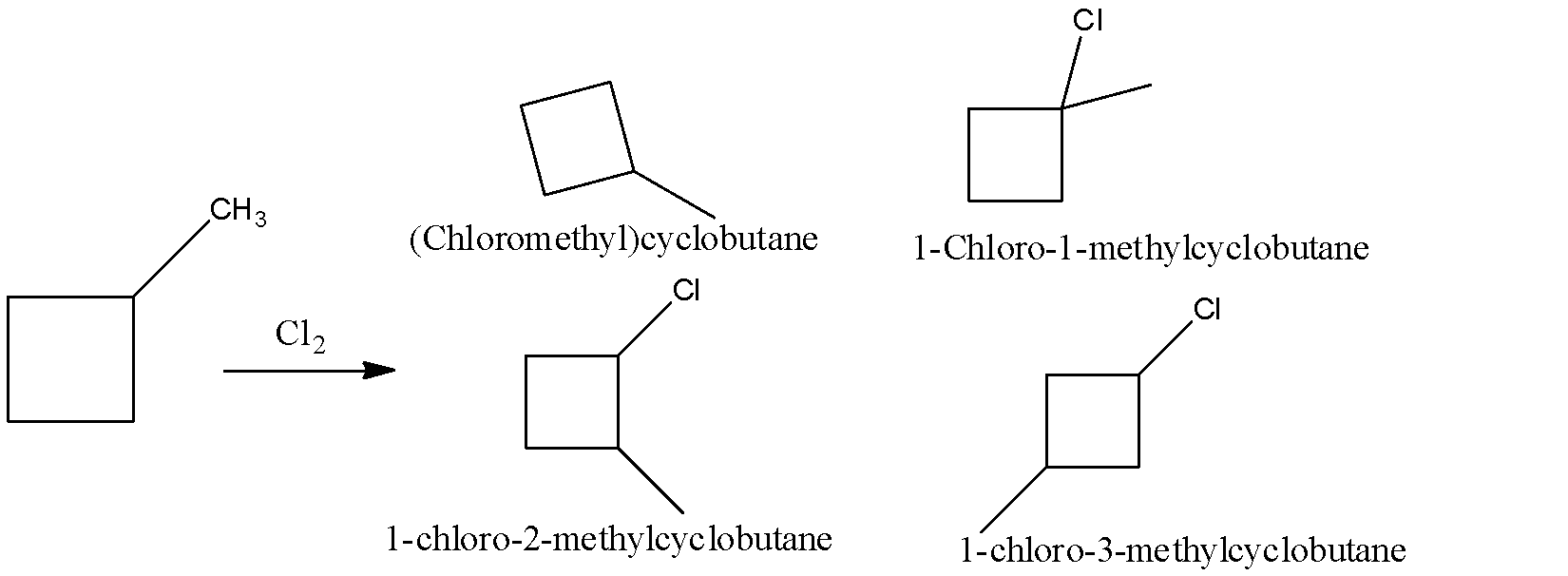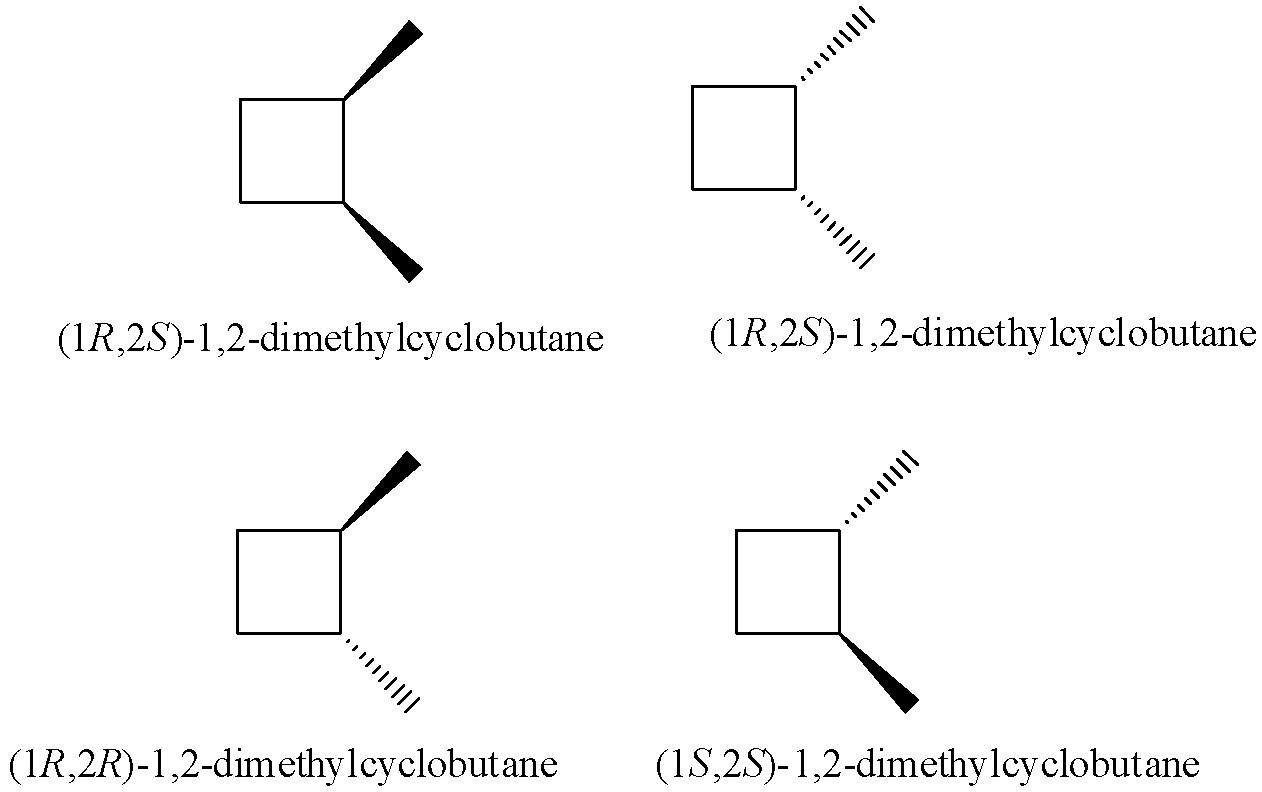
What is the maximum number of isomers (including stereoisomers) that are possible on monochlorination of methylcyclobutane?
Answer
536.1k+ views
Hint: A stereoisomer is a type of isomers in which molecules have the same molecular formula but arranged in differ in the three dimensional orientations. In methylcyclobutane monochlorination is a single chlorine arranged in different places and forming a new compound.
Complete step by step answer:
To calculate the total number of isomers in monochlorination of methylcyclobutane calculate separately all possible isomers of that compound.
Total numbers of carbon in methylcyclobutane = 5
Total numbers of Hydrogen atom in methylcyclobutane = 10
Total number of chlorine in monochlorination of methylcyclobutane = 1
The structural isomers of the monochlorination of methylcyclobutane are:
(Chloromethyl)cyclobutane
1-Chloro-1-methylcyclobutane
1-chloro-2-methylcyclobutane
1-chloro-3-methylcyclobutane

So, there are only 4 structural isomers that can be in the given compound.
Now, calculating the isomers of stereoisomers:
1-chloro-2-methylcyclobutane has two geometrical isomers. Each geometrical isomer has an enantiomer. So there are a total 4 isomers in 1-chloro-2-methylcyclobutane.

1-chloro-3-methylcyclobutane also have two geometrical isomers cis and trans.

So, maximum number of isomers can be of monochlorination of methylcyclobutane are 4+2+2=8
Hence, the correct answer is 8
Note: Cis: If two alkyl groups R- are on the same side of the C=C.
Trans: IF the two alkyl groups R- on the opposite side of the C=C.
Optical isomers: If the two compounds have the same number of atoms and bonds.
Isomers can be found simply by arranging the atoms in different chains and cycles. After looking this see the geometrical isomers cis and trans that is form which have same double bond or not. Finally if the compound is optically then each compound will form dextro -rotatory and leavo-rotatory. One which is on the left and another on the right. Using this find the isomers of the compound in chains or cycling.
Complete step by step answer:
To calculate the total number of isomers in monochlorination of methylcyclobutane calculate separately all possible isomers of that compound.
Total numbers of carbon in methylcyclobutane = 5
Total numbers of Hydrogen atom in methylcyclobutane = 10
Total number of chlorine in monochlorination of methylcyclobutane = 1
The structural isomers of the monochlorination of methylcyclobutane are:
(Chloromethyl)cyclobutane
1-Chloro-1-methylcyclobutane
1-chloro-2-methylcyclobutane
1-chloro-3-methylcyclobutane

So, there are only 4 structural isomers that can be in the given compound.
Now, calculating the isomers of stereoisomers:
1-chloro-2-methylcyclobutane has two geometrical isomers. Each geometrical isomer has an enantiomer. So there are a total 4 isomers in 1-chloro-2-methylcyclobutane.

1-chloro-3-methylcyclobutane also have two geometrical isomers cis and trans.

So, maximum number of isomers can be of monochlorination of methylcyclobutane are 4+2+2=8
Hence, the correct answer is 8
Note: Cis: If two alkyl groups R- are on the same side of the C=C.
Trans: IF the two alkyl groups R- on the opposite side of the C=C.
Optical isomers: If the two compounds have the same number of atoms and bonds.
Isomers can be found simply by arranging the atoms in different chains and cycles. After looking this see the geometrical isomers cis and trans that is form which have same double bond or not. Finally if the compound is optically then each compound will form dextro -rotatory and leavo-rotatory. One which is on the left and another on the right. Using this find the isomers of the compound in chains or cycling.
Recently Updated Pages
Why are manures considered better than fertilizers class 11 biology CBSE

Find the coordinates of the midpoint of the line segment class 11 maths CBSE

Distinguish between static friction limiting friction class 11 physics CBSE

The Chairman of the constituent Assembly was A Jawaharlal class 11 social science CBSE

The first National Commission on Labour NCL submitted class 11 social science CBSE

Number of all subshell of n + l 7 is A 4 B 5 C 6 D class 11 chemistry CBSE

Trending doubts
Differentiate between an exothermic and an endothermic class 11 chemistry CBSE

10 examples of friction in our daily life

One Metric ton is equal to kg A 10000 B 1000 C 100 class 11 physics CBSE

Difference Between Prokaryotic Cells and Eukaryotic Cells

1 Quintal is equal to a 110 kg b 10 kg c 100kg d 1000 class 11 physics CBSE

State the laws of reflection of light




